With a $1.87 billion surplus expected, students, educators and some state lawmakers are calling for the state’s windfall to be invested in education.
Of the surplus, Gov. Mark Dayton and the state legislature will be able to divvy up $1.2 billion. The remaining funding will go back into the state’s reserve and environmental funds.
At a Thursday rally — the same day Dayton announced the $1.87 billion boon — speakers called for some or all of it to go toward education in the state.
“A surplus is an opportunity,” said Rep. Carlos Mariani, DFL-St. Paul, at Thursday’s event at University Baptist Church in Dinkytown. “It gives us a chance to invest back into ourselves, invest in education and into the education of our children.”
He said the decision will come quickly and that concerned Minnesotans should contact legislators about funneling the surplus toward education.
Rep. Phyllis Kahn, DFL-Minneapolis said while there are a number of ways to spend the additional funds, such as issuing tax refunds, she said she’d like the surplus to help student debt and the reinstatement of a tuition freeze at the University of Minnesota.
University graduate student Courtney Gildersleeve said students struggle with debt, sometimes causing them to drop out of school. Minnesota student debt is the fifth highest in the nation.
“We could lower tuition, provide liveable wages for faculty and staff, forgive student debt and take care of mental health at the University,” Gildersleeve said.
University graduate physics student and teacher’s assistant Jarrett Brown spoke at the rally, which University of Minnesota Academics United hosted. He said he’s noticed a need for more instructors and smaller classes at the University — changes that could be possible with extra state funding.
Associate history professor Eva von Dassow said at the rally that students are pressured to graduate in four or five years to avoid amassing more debt. This causes students to struggle with heavy course loads. They also take on multiple jobs and stress that could hinder their learning.
Grade school teachers who spoke at the event said a lack of funding has led to growing class sizes, program cuts and too few counselors for students in their schools.
“We need to invest every last dollar of the budget surplus into education,” fourth grade teacher at Farmington Elementary School
Jennifer York said. “We want to prepare kids for higher education and send them off knowing they won’t be accruing a bunch of debt.”
Still, officials aren’t sure how the surplus will be split.
“It’s way too early to make a prediction of what Gov. Dayton will do with the budget surplus,” said Minnesota Office of Higher Education Commissioner Larry Pogemiller. “The
history of Dayton and higher education has been good but not perfect.”
In a Thursday press release, Gov. Dayton said he will avoid borrowing money from schools, referring to Gov. Tim Pawlenty’s actions to cover budget deficits.
“We had dis-invested [in education] for years,” Rep. Mariani said at the rally. “It’s coming back, but there’s still a long way to go.”







